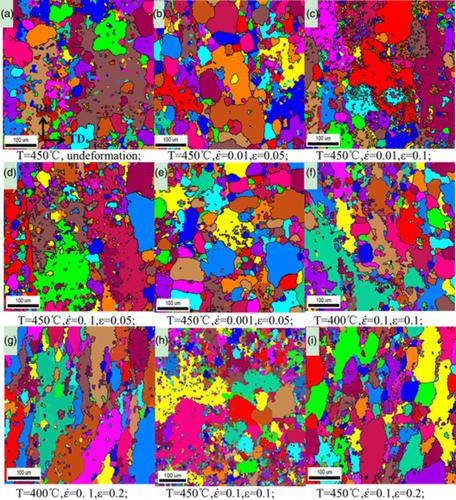当前位置:
X-MOL 学术
›
Microsc. Res. Tech.
›
论文详情
Our official English website, www.x-mol.net, welcomes your
feedback! (Note: you will need to create a separate account there.)
Mechanisms and microstructures of 2A97 Al‐Li alloy under the hot forming with synchronous quenching process
Microscopy Research and Technique ( IF 2.0 ) Pub Date : 2020-09-29 , DOI: 10.1002/jemt.23593 Peng Zhang 1 , Ming‐He Chen 1 , Wei Chen 1, 2 , Shi‐Hong Zhang 3 , Yong Xu 3
Microscopy Research and Technique ( IF 2.0 ) Pub Date : 2020-09-29 , DOI: 10.1002/jemt.23593 Peng Zhang 1 , Ming‐He Chen 1 , Wei Chen 1, 2 , Shi‐Hong Zhang 3 , Yong Xu 3
Affiliation

|
Aluminum‐lithium alloy is regarded as the most promising light material in the aircraft and aerospace industries. For the production of complex and high‐precision parts, the hot forming with synchronous quenching (HFSQ) process has become an effective and attractive forming method. In order to achieve the performance and microstructure evolution of the 2A97 Al‐Li alloy under the HFSQ process, the specimens were subjected to solution treatment at 520°C and held at 90 min in the Gleeble 3,500 thermal simulator. Then the hot tensile test with simultaneous quenching was conducted directly at a temperature of 300–500°C and a strain rate of 0.1–0.001 s−1 with the same equipment. Through analyzing the macroscopic stress–strain curves and microscopic fractures, it was concluded that the optimal forming temperature was 450°C with the strain rate being 0.1 s−1 and its forming mechanism under the process was presented. To obtain the microstructure evolution of 2A97 Al‐Li alloy under the HFSQ process, the material was subjected to constant strain tensile test with synchronous quenching and then treated with two‐stage artificial aging 200°C and 6 hr + 165°C and 6 hr. The microstructure of the alloy was observed by means of electron backscattering diffraction (EBSD). And its evolution process and the influence of temperature, strain rate, and strain on the microstructure under the process were attained.
中文翻译:

2A97铝锂合金同步淬火热成形的机理与组织
铝锂合金被认为是飞机和航空航天业中最有希望的轻质材料。对于复杂和高精度零件的生产,采用同步淬火(HFSQ)工艺的热成型已成为一种有效且有吸引力的成型方法。为了在HFSQ工艺下获得2A97 Al-Li合金的性能和组织演变,将样品在520°C进行固溶处理,并在Gleeble 3,500热仿真器中保持90分钟。然后直接在300–500°C的温度和0.1–0.001 s -1的应变速率下进行同时淬火的热拉伸试验用相同的设备。通过分析宏观应力-应变曲线和微观断裂,可以得出最佳成形温度为450℃,应变速率为0.1 s -1,并给出了该成形过程中的成形机理。为了在HFSQ工艺下获得2A97 Al-Li合金的组织演变,对材料进行同步淬火的恒定应变拉伸试验,然后在200°C和6 hr + 165°C和6 hr的两阶段人工时效中进行处理。 。借助于电子反向散射衍射(EBSD)观察到合金的微观结构。并获得了其演化过程以及温度,应变速率和应变对过程中微观组织的影响。
更新日期:2020-09-29
中文翻译:

2A97铝锂合金同步淬火热成形的机理与组织
铝锂合金被认为是飞机和航空航天业中最有希望的轻质材料。对于复杂和高精度零件的生产,采用同步淬火(HFSQ)工艺的热成型已成为一种有效且有吸引力的成型方法。为了在HFSQ工艺下获得2A97 Al-Li合金的性能和组织演变,将样品在520°C进行固溶处理,并在Gleeble 3,500热仿真器中保持90分钟。然后直接在300–500°C的温度和0.1–0.001 s -1的应变速率下进行同时淬火的热拉伸试验用相同的设备。通过分析宏观应力-应变曲线和微观断裂,可以得出最佳成形温度为450℃,应变速率为0.1 s -1,并给出了该成形过程中的成形机理。为了在HFSQ工艺下获得2A97 Al-Li合金的组织演变,对材料进行同步淬火的恒定应变拉伸试验,然后在200°C和6 hr + 165°C和6 hr的两阶段人工时效中进行处理。 。借助于电子反向散射衍射(EBSD)观察到合金的微观结构。并获得了其演化过程以及温度,应变速率和应变对过程中微观组织的影响。











































 京公网安备 11010802027423号
京公网安备 11010802027423号